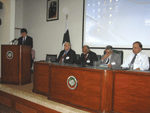
The threat of HIV/AIDS infection in Pakistan is increasing progressively. The main focus of HIV infection detected so far lies in the intra-venous drug users (IDUs) and to a lesser extent in male and hijra sex workers. Female sex workers from the low income groups have a surprisingly low prevalence of HIV infection. This was disclosed by Dr. Hasan Abbas Zaheer, Manager, National AIDS Control Programme, Government of Pakistan, in the Symposium on HIV/AIDS in Pakistan, at the 33rd Annual Congress of the Pakistan Association of Pathologists, held recently at the Pakistan Institute of Medical Sciences, Islamabad.
Pakistan, which was previously thought of a country with a low-level of infection has now moved up to the group of “Countries in Transaction,” where the HIV AIDS problem is increasing since the last 5 years.
In 2005-6, only 9% of the IDUs tested were infected with the AIDS virus (called HIV +ve), in 2006-7, it increased to 15.8%, and in 2007-8, more than 20% of IDUs were found to be HIV +ve. The main reason for this, Dr Zaheer said, was the sharing of infected needless and syringes by IDUs and other high risk activity groups.
The National AIDS Control Programme is providing extremely expensive treatment totally free of cost to any person who is found to be suffering from AIDS. The NACP has extablished 20 AIDS treatment centres all over the country, of which 13 are for adults and 7 for Prevention of Mother to Child Transmission (PMCT).
Dr. Hasan also highlighted the recent achievement of the NACP, which included the approval of the AIDS Programme PC-1s by the ECNEC, Revival of the German funded Safe Blood Transfusion project, Strengthening of National HIV/AIDS/STIs Referral Laboratory, Revision of the National HIV estimates, Operationalization of the National M&E framework, Organization of the National Meeting on Migrant Workers 2009 at the World Health Assembly Session in Geneva, National Consultations on the scaling up the response among IDUs, FSWs, and MSMs, and development of international linkages with organization like the Clinton Foundation, Centres of Disease Control, Atlanta, USA, and the London School of Hygiene Tropical Medicine, London UK.
Prof. Farah Mustafa, Professor and Head of Department of the BioSciences, COMSATS Institute of Information Technology, Islamabad spoke in detail the immunology and virology of the human immunodeficiency virus (HIV) which causes AIDS (Acquired Immune Deficiency Syndrome). She explained that there are two main subtypes of HIV,viz. 1 & 2, of which HIV-1 is predominant in Pakistan. HIV-1 has further subtypes, called clades, of which type A is has been found to be present in Pakistan. Previously it was thought that type C is the predominant clade, since type C is present in India.
Prof. Khalid Hasan, Professor of Hematology, Pakistan Institute of Medical Sciences, Islamabad, highlighted the hematological manifestation of HIV/AIDS. In addition to explaining the subject in detail, he also presented data of the 31 cases of AIDS, whose bone marrow examination had been conducted in PIMS, from January 2005 to June 2009. He said that the predominant symptoms of these AIDS cases were anemia and fever, and almost a quarter had a previous infection of tuberculosis.
Prof. Muhammad Mukhtar, Professor of Biochemistry, University of Arid Agriculture, presented some exceptional, cutting edge, original research in his paper on the Metabolic Effects and Opportunistic Infection in HIV/AIDS. He highlights how the AIDS virus affects the hormonal status of the patients. He showed those people infected by HIV-1 are at a greater risk of developing neurological ailments. His study was just published in the internationally renowned Journal of Virology in October 2009. He also showed that tuberculosis, fungal infections of the mouth and washing syndrome were important associations in HIV patients.
He highlight the WHO report which stated that Pakistan in the 8th country in the world having the most Multiple Drug Resistant (MDR) type of TB, and sixth in the world having Extreme Drug Resistant (XDR) TB.
Prof. Mukhtar is working on an extract from a plant found in Cholistan to treat fungal infections.
Prof. Rizwan Qazi, Associate Professor of Medicine, Pakistan Institute of Medical Sciences, Islamabad, who is the Clinician incharge of the HIV Treatment Centre at PIMS, very eloquently explained the different clinical presentations of HIV infection and AIDS. More 70-80% of HIV infected people do not have any signs and symptoms and feel perfectly well. When the actual illness starts, patients start experiencing fever, fatigue, and generalized aches and pains. This can be accompanied with a sore throat and enlarged lymph nodes in the neck. The next stage includes unexplained weight loss of more then 10% of the body weight and persistent diarrhoea within one month.
Dr. Nadeem Ikram, Senior Manager, NACP HIV/AIDS Referral Laboratory, Islamabad, discussed the various means of testing for HIV/AIDS
Prof. Khurshid Ahmad, Scientist Emeritus, National Institute of Health, Islamabad, and Consultant to the National AIDS Control Programme, provided an extremely enlightening overview of Quality Assurance in the testing for HIV infection. He also delved upon the role of a referral laboratory and discussed ways and means of bringing the National HIV/AIDS Referral Laboratory up to international standards
The meeting was chaired by two eminent immunologists, Brigadier Dr. Tahir Aziz Ahmed, Consultant Immunologist at the Armed Forces Institute of Pathology, Rawalpindi, and Dr M Osman Yusuf, who is the co-founder of the National AIDS Control Programm an international Consultant on HIV/AIDS, as well as on Allergy and Asthma.
